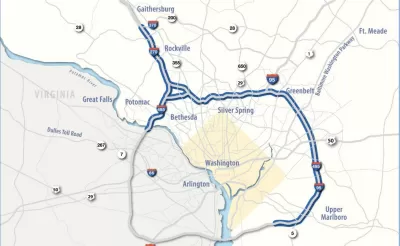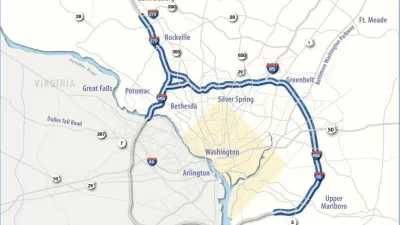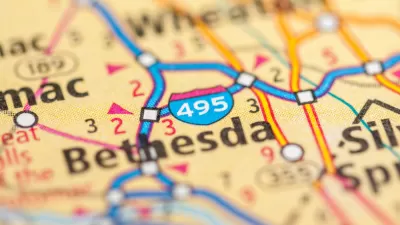Maryland Governor Wes Moore is differentiating his new administration from his predecessor’s, but some projects, like the widening of federal highways in the Capital Beltway, stay the same.

Observers hopeful that new Maryland Governor Wes Moore’s commitment to the defunct Red Line transit project in Baltimore was a sign of a less auto-centric vision for the future of transportation in Maryland might be disappointed.
Gov. Moore is moving forward with a plan to widen parts of the Capital Beltway and Interstate 270—a key piece of former Governor Larry Hogan’s transportation planning agenda for the state. Unlike Hogan’s approach, however, Moore’s vision for the project is scrapping the troubled public-private partnership.
“The Maryland Department of Transportation has applied for a $2.4 billion federal grant that officials said would help the state realize long sought improvements at one of the biggest traffic chokepoints in the Washington region by 2031,” reports Luz Lazo in a paywalled article for the Washington Post.
Lazo adds: “Moore’s plan would rebuild the American Legion Bridge and add managed lanes — such as high-occupancy toll lanes — to parts of the Capital Beltway and Interstate 270, targeting crippling highway congestion at the Virginia state line and in the Maryland suburbs with a focus on transit and more community input, officials said.” Governor Moore claims the widening plan is consistent with his administration’s “Leave No One Behind” agenda. “The transportation network throughout Maryland and the National Capital Region must be able to get people where they need to go in a timely and reliable manner,” said Governor Moore in a press release. “Providing long-desired, equitable transportation solutions in the American Legion Bridge and I-270 corridors is critical to eliminating employment barriers, linking more people to high-demand jobs and stimulating local economies."
The I-495/I-270 Managed Lanes Project has been in the works since 2017, finally gaining federal approval in August 2022 after moving forward in fits and starts over the years and facing local opposition and legal peril.
FULL STORY: Maryland pursues publicly funding Beltway relief project [paywall]

Planetizen Federal Action Tracker
A weekly monitor of how Trump’s orders and actions are impacting planners and planning in America.

Canada vs. Kamala: Whose Liberal Housing Platform Comes Out on Top?
As Canada votes for a new Prime Minister, what can America learn from the leading liberal candidate of its neighbor to the north?

The Five Most-Changed American Cities
A ranking of population change, home values, and jobs highlights the nation’s most dynamic and most stagnant regions.

San Diego Adopts First Mobility Master Plan
The plan provides a comprehensive framework for making San Diego’s transportation network more multimodal, accessible, and sustainable.

Housing, Supportive Service Providers Brace for Federal Cuts
Organizations that provide housing assistance are tightening their purse strings and making plans for maintaining operations if federal funding dries up.

Op-Ed: Why an Effective Passenger Rail Network Needs Government Involvement
An outdated rail network that privileges freight won’t be fixed by privatizing Amtrak.
Urban Design for Planners 1: Software Tools
This six-course series explores essential urban design concepts using open source software and equips planners with the tools they need to participate fully in the urban design process.
Planning for Universal Design
Learn the tools for implementing Universal Design in planning regulations.
Central Transportation Planning Staff/Boston Region MPO
Heyer Gruel & Associates PA
Institute for Housing and Urban Development Studies (IHS)
City of Grandview
Harvard GSD Executive Education
Regional Transportation Commission of Southern Nevada
Toledo-Lucas County Plan Commissions




























